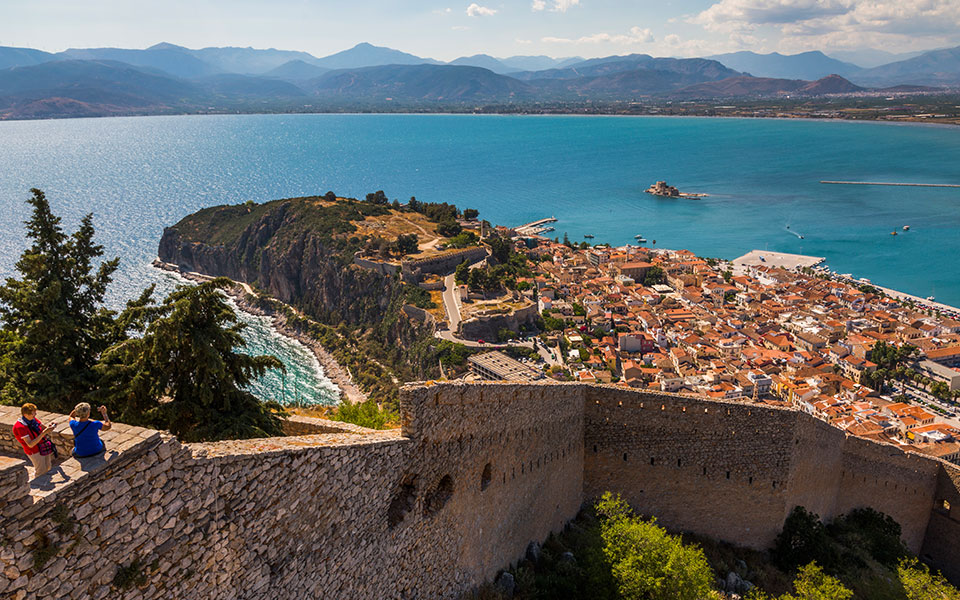It is widely known that Greece boasts an immense history that stretches back many thousands of years. And while most people associate this corner of the Mediterranean with the glories of Classical antiquity (5th and 4th centuries BC), it’s easy to overlook the fact that Greece is home to some of Europe’s most important medieval sites, including a significant number of well-preserved castles and fortresses.
From mountaintop citadels to coastal strongholds, each fortress tells a compelling story of the ever-shifting tides of power in this region during the Middle Ages, from the conflicts between the Byzantines, Franks, and Venetians, to the meteoric rise of the Ottoman empire.
Here we embark on a journey to discover eight of the country’s most iconic castles and fortresses, where every stone whispers tales of battle-hardened knights, foreign invaders, and fallen kingdoms.
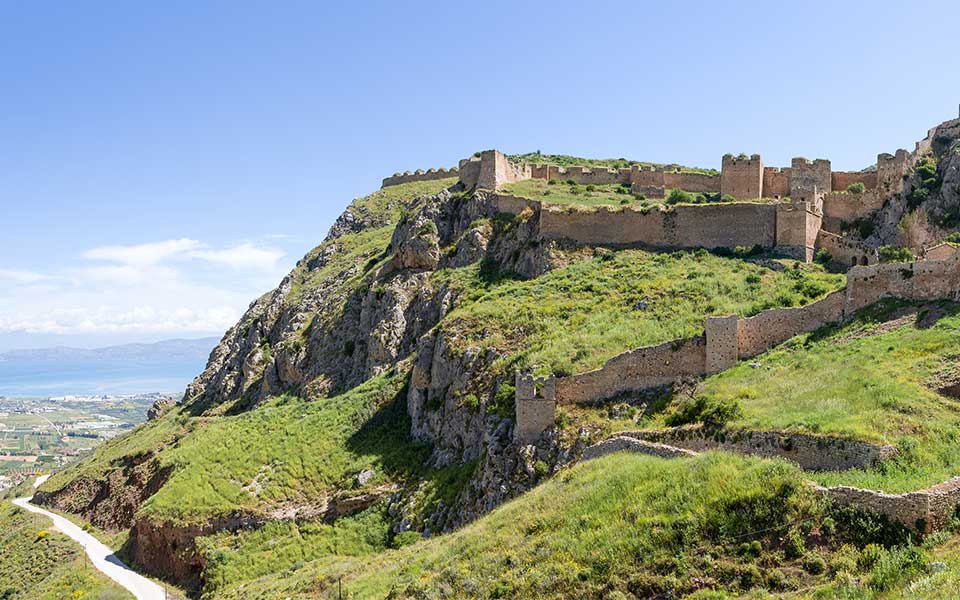
© Shutterstock
Acrocorinth, Corinth
Perched atop a towering monolithic rock in the northeast Peloponnese, the fortress of Acrocorinth – the acropolis of ancient Corinth – is without doubt the most impressive in Greece. Its easily defensible position, by virtue of its geomorphology, made it a formidable stronghold, standing guard over the strategically vital Isthmus, and boasting unbroken views of the Corinthian Gulf to the west and the Saronic Gulf to the east.
Dating back to at least the 7th century BC, the highest peak of Acrocorinth served as a sanctuary for the cult worship of Aphrodite. It later became a significant military stronghold during the Hellenistic period (323-31 BC), operating as a Macedonian garrison that asserted control over Greek city-states in the south. The site’s fortifications, including three circuit walls, gates, and towers, showcase the contributions of the ancient Greeks, Romans, Byzantines, Franks, Venetians, and Ottomans, each leaving their indelible mark on the citadel.
The Byzantines extensively fortified Acrocorinth after the mid-7th century AD, cementing its strategic importance as the seat of the “strategos” (general) of the Peloponnese. The Venetians further strengthened its defenses in the 13th century, adding towers and gates. Acrocorinth also played a pivotal role during the Ottoman period and later saw action in the Greek War of Independence.
Visitors to Acrocorinth today can explore its well-preserved ruins, including the remains of the Temple of Aphrodite, which was later converted into a church in the 5th century AD and then a mosque, as well as the Upper Peirene, a sacred spring located within the walls.
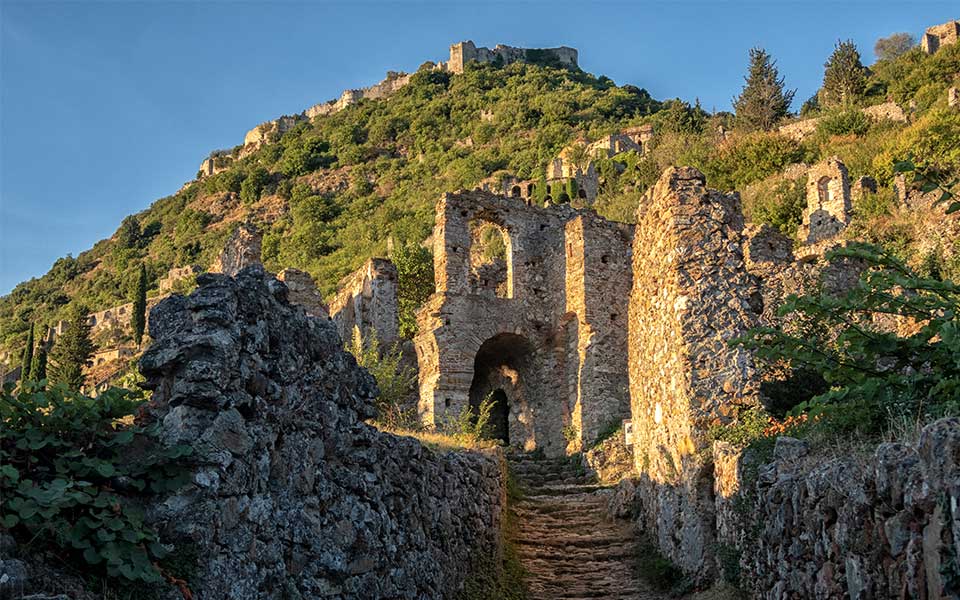
© Shutterstock
Mystras, Peloponnese
In the southern Peloponnese, nestled amid lush forests on the slopes of Mount Taygetos, the fortified town of Mystras stands as a hauntingly beautiful testament to Greece’s medieval past. Founded in the mid-13th century AD by William II of Villehardouin, ruler of the Frankish Principality of Achaea, and later captured by the Byzantines, Mystras developed into a thriving city under the Palaiologos dynasty, serving as the capital of the Byzantine Despotate of the Morea in the 14th and 15th centuries.
The city’s layout includes the Lower, Middle and Upper Towns, and the Frankish castle of Villehardouin, each offering a glimpse into the settlement’s medieval grandeur. Wandering the footpaths and old terraces, visitors can explore the well-preserved Metropolitan Church of Aghios Demetrios, the imposing Palace of the Palaiologi, and the majestic Church of Aghia Sophia, home to some of Greece’s most important frescoes from the Late Byzantine period.
Mystra’s decline began in the 15th century, and was badly looted by the Ottomans in the decades leading up to the Greek Revolution. It became the site of a bloody massacre in 1823, when the Egyptians killed the local population and raided the surrounding villages. In 1989, UNESCO recognized Mystras as a World Heritage site, celebrating its architectural significance and the valuable insights it provides into the final chapters of the Byzantine empire.
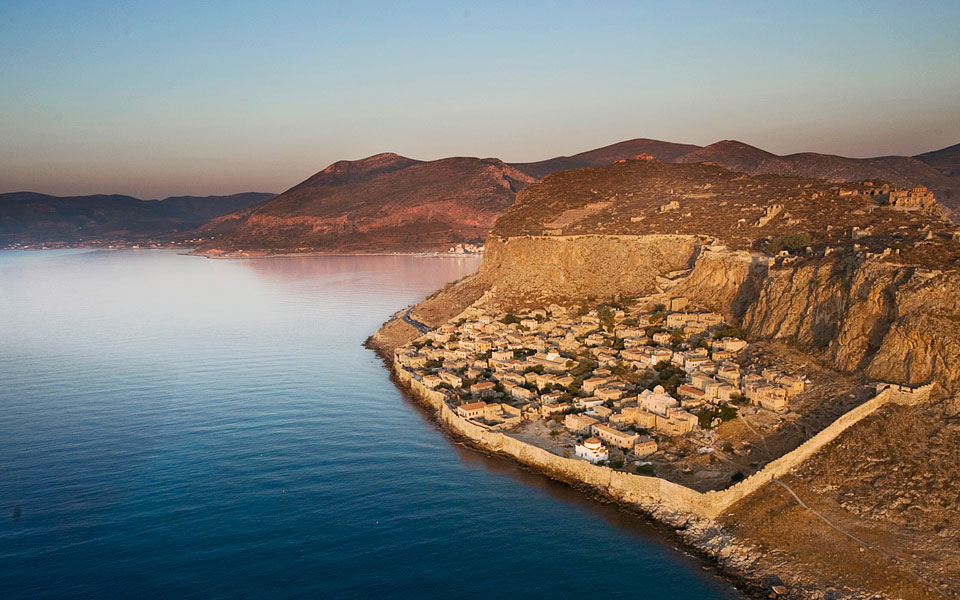
© Perikles Merakos
Monemvasia, Peloponnese
Nicknamed “the Gibraltar of the East,” the medieval fortress town of Monemvasia sits on a tied island off the southeast coast of the Peloponnese, connected to the mainland by a narrow, 400m-long tombolo (causeway). Rising majestically above the sea, Monemvasia exudes an aura of medieval mystique, and is one of the oldest continually inhabited fortified towns in Europe.
Founded in the 6th century, Monemvasia flourished as a strategic trading post during the Byzantine and Venetian periods. The town’s name, meaning “single entrance,” reflects its unique geography and impregnable natural defenses. Narrow cobblestone lanes wind through well-preserved Byzantine churches, Venetian mansions, and hidden squares, evoking a sense of time suspended.
The fortress’s strategic significance drew the attention of various powers, from Byzantine emperors to Frankish crusaders and Ottoman Turks. Venetians, who controlled Monemvasia in the second half of the 15th century, added fortifications, strengthening its role as a maritime hub. In the following centuries, it changed hands again, back and forth between the Venetians and Turks, until it was liberated in the wake of the Greek War of Independence in the early 19th century.
Declared an archaeological site in the 1970s, Monemvasia’s restoration efforts have preserved its medieval charm. A popular getaway for romantic couples, visitors can explore landmarks like the Church of Aghia Sophia, the medieval walls, and the elegant homes of wealthy Venetian merchants.

© Perikles Merakos
Palamidi Fortress, Nafplio
Palamidi Fortress, perched majestically on the crest of a 216m-high hill above the town of Nafplio, is a testament to both Venetian military engineering and the tumultuous history of the Peloponnese. Built by the Venetians towards the end of their second period of occupation (1686-1715), the fortress crowns the rocky Akronafplia Peninsula and commands unparalleled views of the Argolic Gulf.
Completed in 1714, Palamidi was designed by the Venetian fortification engineer Antonio Giancix. Its intricate fortifications include eight bastions that could operate independently, connected by a series of formidable walls and staircases. The sheer grandeur of the fortress, with its 913 winding steps (locals will say “999”) leading to the summit, captures the imagination of visitors.
Palamidi, named after the Homeric hero Palamidis, played a crucial role in various conflicts, witnessing Venetian, Ottoman, and later Greek control. It famously fell to the Greeks during the War of Independence in 1822 after a daring ascent by Staikos Staikopoulos and his men, who bypassed the formidable defenses. Nafplio served as the original capital city of the newly independent Greek state from 1829 until 1824.
Exploring Palamidi today unveils a well-preserved complex of labyrinthine passages, eight bastions (six were renamed after ancient Greek leaders and heroes), a chapel dedicated to Aghios Andreas, and former military quarters. The “Miltiades” bastion, one of the largest, was converted into a prison in 1840, and remained in operation until 1926.
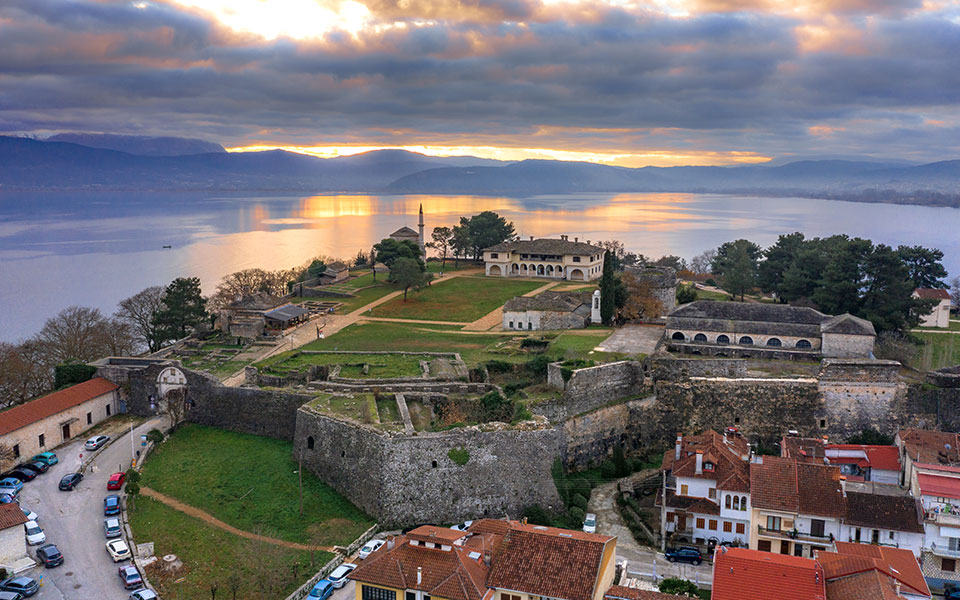
© Unsplash
Ioannina Castle, Epirus
Ioannina Castle, situated in the picturesque region of Epirus in northwest Greece, is a historic fortress that can trace its origins back to the Hellenistic period (4th – 3rd centuries BC). The fortress, which encircles the old town, located on the southeastern corner of the modern city, is surrounded by the tranquil waters of Lake Pamvotis and flanked by the spectacular Pindus Mountains.
According to recent archaeological excavations, the earliest foundations of the castle date back to a Hellenistic-era fort, upon which the Byzantines, in the 10th century, built a much larger castle and defensive walls. The southeastern tower was built by the Normans in the late 11th century, during their short-lived occupation of the area under the leadership of Bohemond of Taranto (c. 1054-1111), principal commander of the First Crusade.
The castle underwent significant expansions and renovations under Ottoman rule (1430-1913), transforming it into a key military stronghold in the region, blending Ottoman and Byzantine architectural features. Notably, it was the center of Ali Pasha’s rule in the late 18th and early 19th centuries, the primary seat of power for a semi-autonomous territory that included parts of central and southern Albania and northern Greece.
During this time, the southeastern citadel was completely rebuilt and became Ali Pasha’s main residence, known by its Ottoman name “Its Kale.” The iconic Fethiye Mosque, “The Mosque of Conquest,” first erected in 1430, was also extensively remodeled by Ali Pasha in the late 18th century, becoming the main mosque of his palace. He is buried there along with one of his wives.
Today, visitors can explore the castle’s winding passageways, massive stone walls, battlements, and towers, as well as the on-site Byzantine Museum.
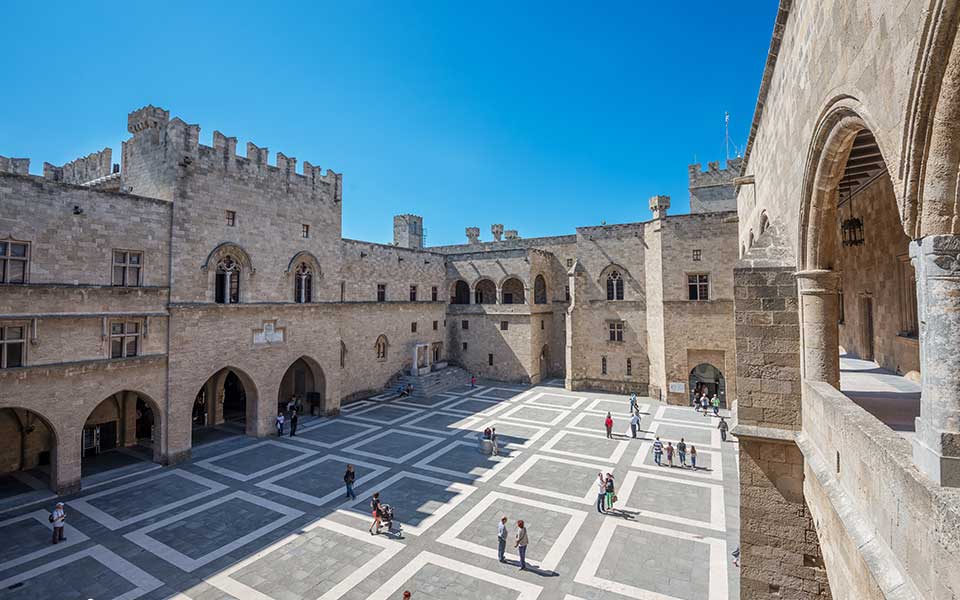
© Shutterstock
The Palace of the Grand Master, Rhodes
The Medieval City of Rhodes, a UNESCO World Heritage site since 1988, is one of the most outstanding and best-preserved examples of a medieval fortified city in the Mediterranean. At its heart stands the majestic Palace of the Grand Master, an enduring legacy of the period when the island was occupied by the chivalric Order of Knights of St. John of Jerusalem, commonly known as the Knights Hospitaller, from 1309 to 1523.
Heavily fortified by the Knights in the 14th century, the city’s meandering streets bear witness to various influences, including earlier Byzantine, and later Ottoman and Italian layers of occupation, making it a captivating mosaic of architectural styles. The old city is located within a 4 km-long wall, long considered to be impregnable (12m-thick in some places), and is divided into a high town to the north and a lower town to the south-southwest.
The Knights were organized into seven “tongues,” each having its own seat, or “inn.” The inns of the tongues of Italy, France, Spain and Provence lined the principal east-west axis, the famous Street of the Knights, on both sides, and remains one of the finest examples of Gothic urbanism in the Mediterranean.
The Palace of the Grand Master, initially constructed in the 14th century, underwent extensive restoration under Italian rule in the early 20th century. Today, it stands as a magnificent example of medieval castle architecture with elements of Gothic and Renaissance styles.
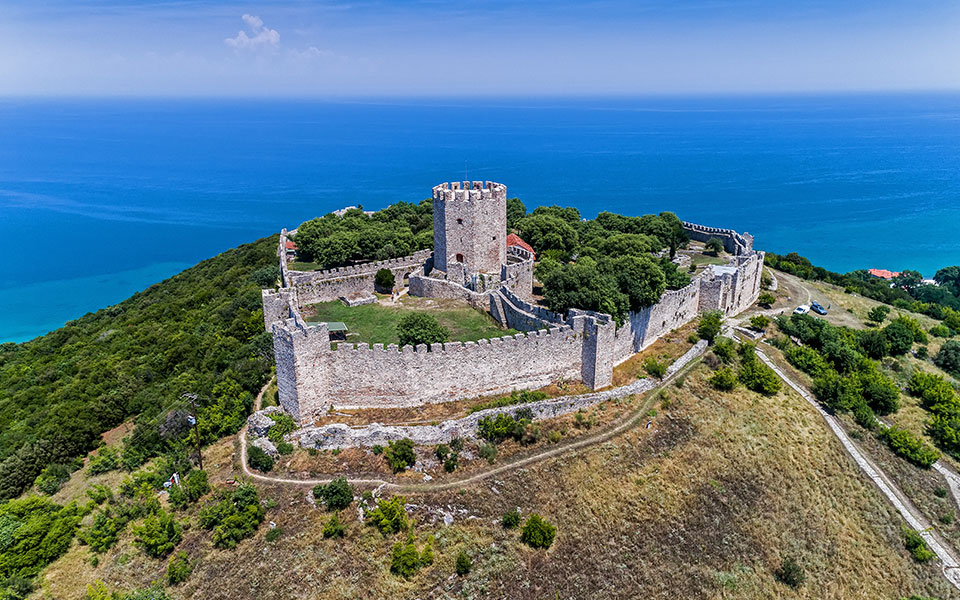
© Shutterstock
Platamon Castle, Macedonia
Platamon Castle, perched on the southeastern tip of Mount Olympus in Central Macedonia, stands as a testament to the Pieria region’s rich history and strategic importance. This imposing medieval fortress, dating back to the early 13th century, was built by the Crusaders under the command of Boniface of Montferrat (c. 1150-1207) during Frankish rule. Its primary purpose was to keep watch for incoming pirate attacks and guard the narrow exit of the Tempe valley, a vital trade route connecting Macedonia with Thessaly and the rest of Greece.
Archaeological excavations at the hilltop fortress and its immediate environs have unearthed structures that date back to Classical antiquity, confirming the site originally belonged to the ancient city of Herakleion, mentioned in the writings of Scylax of Karyanda (in the so-called “Periplus of Pseudo-Scylax,” mid-4th century BC). Boasting panoramic views of the Thermaic Gulf and surrounding landscape, the strategic importance of the settlement continued long into the Roman period.
Much of what is visible of the castle today was built in the wake of the Fourth Crusade (1202-1204), following the establishment of the short-lived Crusader State in the region, the Kingdom of Thessaloniki. The castle was then taken over by the Byzantines in 1218, under the leadership of the noble Komnenos dynasty, and completed in 1222.
The Venetians enjoyed a brief period of sovereignty in the early 15th century, after which the castle was occupied by the Ottoman Turks for the next 400 years, who, in turn, added and modified sections of the defensive walls, towers, and bastions.
Today, visitors can explore the well-preserved walls, 2m thick in some places, the 16m-high octagonal-shaped tower in the northeast side of the complex, and the small church of Aghia Paraskevi. A number of well-preserved medieval cannons can also be found at various positions along the walls. Open air theatrical and musical performances take place here during the summer months.
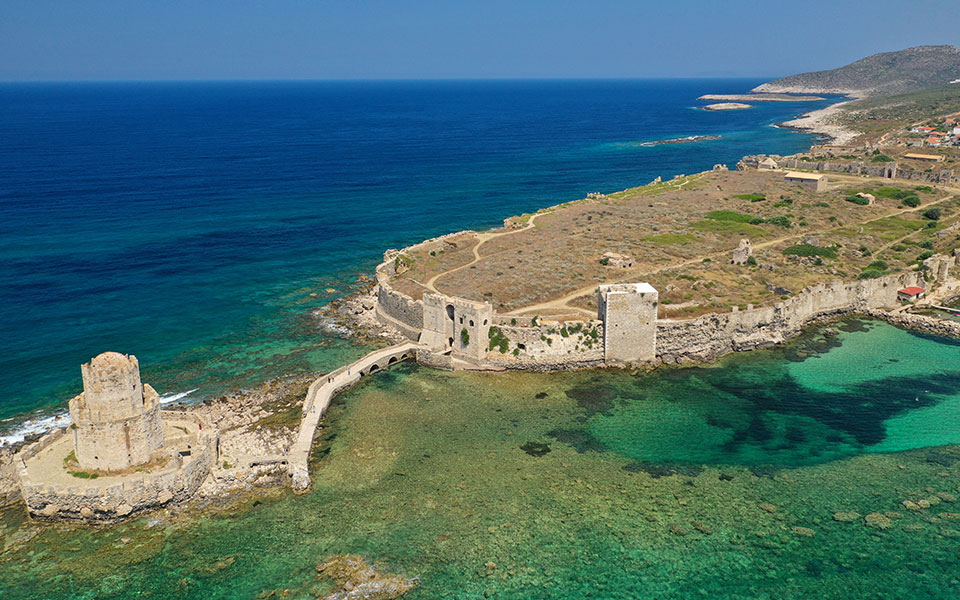
© Shutterstock
Methoni Castle, Messinia
Methoni Castle, located on the coast of Messinia in the southwest Peloponnese, is a well-preserved Venetian fortress dating back to the early 13th century. Its massive walls and strategic location made it a key maritime stronghold throughout the Middle Ages and later Ottoman period, guarding the entrance to the Ionian Sea.
The castle’s impressive fortifications were originally surrounded by a wide sea moat; the only access to and from the mainland was across a stone bridge of 14 arches. Visitors today can still see the iconic symbol of the Venetian Republic, the winged lion of St Mark, emblazoned above the main gate. Immediately to the south of the fortress, on a tiny islet connected by a narrow pathway, lies a domed, octagonal tower known as the “Bourtzi.”
Methoni played a crucial role during the conflicts between Venice and the Ottoman empire. The Turks seized the fortress in 1500, marking a period of Ottoman rule. The site underwent various modifications, including the addition of a mosque and bathhouses. In the 17th century, the Venetians, with the support of the Knights of Malta, the Papal States and France, briefly reclaimed Methoni during the Cretan War (1645-1669), but eventually lost it again to the Ottomans, reflecting the constant ebb and flow of power in the region.
Exploring Methoni Castle today reveals a well-preserved archaeological site with the remnants of Byzantine churches, Venetian houses, a mosque, and the remains of two Ottoman bathhouses.

